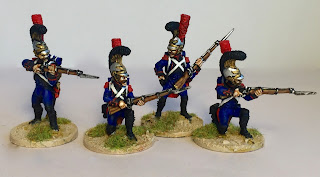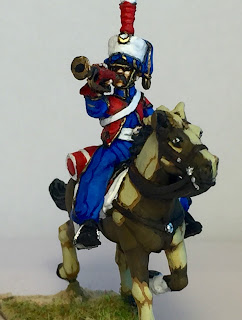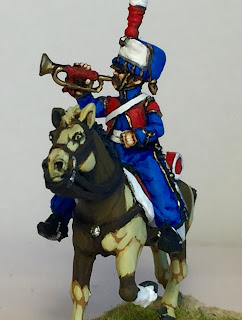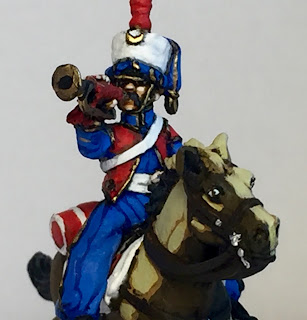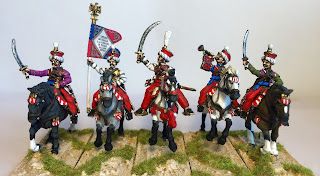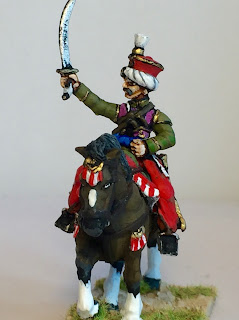I never thought Front Rank could be outdone Napoleonic wise but I have to say that I absolutely love these figures from Gringos 40. The horses in particular are spectacular and I've thoroughly enjoyed painting them.....The range is so unusual I've added some explanatory text..enjoy!
28mm French Marins del a Garde Impériale
Marines of the Imperial Guard
Raised from sailors of the French navy who had distinguished themselves, the battalion of Marins wore a distinctive, elaborate uniform resembling that of the hussars. Their officers bore titles of rank derived from their seagoing compatriots, and the overall commander of the marines bore the rank of Capitaine de Vaisseau. Their duties including manning boats and other watercaft used by the Emperor.
28mm French Sapeurs del a Garde Impériale
Engineers of the Imperial Guard
(I have my eye on the Fire Pump as well!)
Although not deployed in combat as a unit, the Engineers (Genie de la Garde Impériale) created in 1804 as the engineers of the Consular Guard, participated in combat more so than the combat units of the Guard which were usually held in reserve. By 1810 the Chief Engineer officer of the Guard had a company of Sapeurs de la Garde (140 sappers), all members of the Old Guard. In 1813 this was increased to two companies, and later one battalion of four companies totaling 400 sappers. The 1st and 2nd companies were classed as Old Guard, while the 3rd and 4th companies as the Young Guard.
28mm French Gendarmes d'élite de la Garde Impériale
Elite Gendarmes of the Imperial guard
This was a gendarmerie unit formed in 1801 by Napoleon as part of the Consular Guard which became the Imperial Guard in 1804. In time of peace, their role was to protect official residences and palaces and to provide security to important political figures. In time of war, their role was to protect the Imperial headquarters, to escort prisoners and occasionally to enforce the law and limit civil disorder in conquered cities. The unit last saw action at the battles of Ligny and Waterloo during the 100 days.
28mm Escadron de Lithuanian Tartares
Lithuanian Tartars of the Imperial Guard
Lithuanian Tartars of the Imperial Guard
A regiment of Lithuanian Lancers was raised as the 3e Régiment de Chevau-Légers-Lanciers de la Garde Impériale in Lithuania during the invasion of Russia in 1812, largely from the Lithuanian population in Poland, but was virtually destroyed in the retreat of the same year, and the survivors incorporated into 3e Régiment de Eclaireurs which included a squadron of Tartars the Escadron de Lithuanian Tartares.
28mm Mamelukes del a de la Garde Impériale
Mamelukes
A squadron of Mamelukes (Escadron de Mamalukes) returned with Napoleon from the Egyptian Campaign in 1799. They were inducted into the Guard, and usually attached to the Chasseurs à Cheval. The squadron was never increased to a regiment in strength. Over the years their casualties were replaced from French cavalry regiments, or from any vaguely Middle Eastern related nationalities.
Probably my Favourites !
Found an old horse in my bits box to base with this dismounted chap
General Jean-Andoche Junot, 1st Duke of Abrantès
Junot was born in Bussy-le-Grand, Côte-d'Or, son of Michel Junot, a farmer. He was studying law in Dijon when the French Revolution started. He joined a volunteer battalion, was twice wounded and made sergeant. He first met Napoleon Bonaparte during the Siege of Toulon in 1793 when he became his secretary
Junot's major command was during the Peninsular War. He commanded the 1807 Invasion of Portugal. Setting out in November from Salamanca, his vanguard accomplished a bloodless occupation of Lisbon on 30 November. For this feat, he was granted the ducal victory title of Duc d'Abrantès and was made Governor of Portugal
In the Russian campaign Junot's record was erratic; he was blamed for allowing the Russian army to retreat following the Battle of Smolensk (17 August), but at the Battle of Borodino (7 September 1812) he commanded the 8th Corps competently.
In 1813 he was made Governor of the Illyrian Provinces but his growing mental instability led to him being returned to France. Many think he committed suicide in Montbard.










